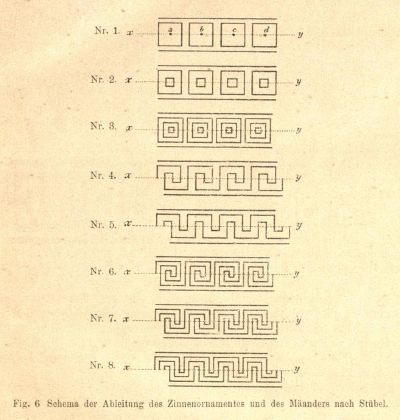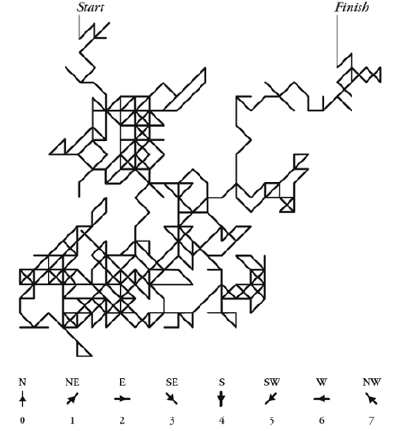(add connection games and tiling systems) |
(Add thumbnails from codepen) |
||
| (14 intermediate revisions by the same user not shown) | |||
| Line 1: | Line 1: | ||
= Meandering Curves = | = Meandering Curves = | ||
----- | |||
== Introduction == | == Introduction == | ||
| Line 34: | Line 35: | ||
=== Literature === | === Literature === | ||
==== Meanders ==== | ==== Meanders ==== | ||
* Hans-Henrik Stølum: [http://raaf.org/pdfs/meandering_river.pdf River Meandering as a Self-Organization Process] (1996) | * Hans-Henrik Stølum: [http://raaf.org/pdfs/meandering_river.pdf River Meandering as a Self-Organization Process] (1996) | ||
| Line 43: | Line 43: | ||
* Tim Ingold: ''Lines: a brief history'' (2007) — ISBN 978-0415424271 (hint: [https://www.google.de/#q=Lines:+a+brief+history google it]) | * Tim Ingold: ''Lines: a brief history'' (2007) — ISBN 978-0415424271 (hint: [https://www.google.de/#q=Lines:+a+brief+history google it]) | ||
* Wassily Kandisky: ''[http://bibliothequekandinsky.centrepompidou.fr/imagesbk/RLPF728/M5050_X0031_LIV_RLPF0728.pdf Punkt und Linie zu Fläche]'' (1926) | * Wassily Kandisky: ''[http://bibliothequekandinsky.centrepompidou.fr/imagesbk/RLPF728/M5050_X0031_LIV_RLPF0728.pdf Punkt und Linie zu Fläche]'' (1926) | ||
==== Labyrinths and Mazes ==== | ==== Labyrinths and Mazes ==== | ||
| Line 54: | Line 53: | ||
* E.Gail Hutchinson and Janet M.Thornton: [http://peds.oxfordjournals.org/content/6/3/233.full.pdf The Greek key motif: extraction, classification and analysis] (1993) | * E.Gail Hutchinson and Janet M.Thornton: [http://peds.oxfordjournals.org/content/6/3/233.full.pdf The Greek key motif: extraction, classification and analysis] (1993) | ||
----- | |||
== Collaborative Drawing == | == Collaborative Drawing == | ||
| Line 72: | Line 72: | ||
Sol Lewitt's [http://www.thegundgallery.org/2013/07/sol-lewitt/ Walldrawing] from the Do It Exhibition (2001): | Sol Lewitt's [http://www.thegundgallery.org/2013/07/sol-lewitt/ Walldrawing] from the Do It Exhibition (2001): | ||
:''A black not straight line is drawn at approximately the center of the wall horizontally from side to side.'' | |||
:''Alternate red, yellow and blue lines are drawn above and below the black line to the top and bottom of the wall'' | |||
More walldrawings in this [http://massmoca.org/sol-lewitt/ retrospective]. | More walldrawings in this [http://massmoca.org/sol-lewitt/ retrospective]. | ||
| Line 96: | Line 96: | ||
=== Connection Games === | === Connection Games === | ||
* Wikipedia: [[wikipedia:Hex_(board_game)|Hex Board Game]] | * Wikipedia: [[wikipedia:Hex_(board_game)|Hex Board Game]] | ||
* Cameron Browne: ''Connection Games: Variations on a Theme'' — ISBN 978-1568812243 | * Cameron Browne: ''Connection Games: Variations on a Theme'' (2003) — ISBN 978-1568812243 | ||
* John Conway: ''Winning Ways for Your Mathematical Plays'' (1982) [https://lhwei.gbv.de/FAM?PPN=031635741 Gewinnen: Strategien für mathematische Spiele] | * John Conway: ''Winning Ways for Your Mathematical Plays'' (1982) — [https://lhwei.gbv.de/FAM?PPN=031635741 Gewinnen: Strategien für mathematische Spiele] | ||
=== Tiling Systems === | === Tiling Systems === | ||
* Dominique Douat [https://github.com/bitcraftlab/10PRINT/raw/master/lit/douat.pdf Méthode pour faire une infinité de desseins differens] | * Dominique Douat: [https://github.com/bitcraftlab/10PRINT/raw/master/lit/douat.pdf Méthode pour faire une infinité de desseins differens] (1722) | ||
* Keith Haring [https://twitter.com/bitcraftlab/status/697814780753616897 Drawings for Multiple Figures from 8 Seperate Tiles] (1982) | * Keith Haring: [https://twitter.com/bitcraftlab/status/697814780753616897 Drawings for Multiple Figures from 8 Seperate Tiles] (1982) | ||
* BoardGame Geek [https://boardgamegeek.com/geeklist/54579/games-inspired-truchet-tiles Games inspired by Truchet Tiles] | * BoardGame Geek: [https://boardgamegeek.com/geeklist/54579/games-inspired-truchet-tiles Games inspired by Truchet Tiles] | ||
=== Reading Lists === | === Reading Lists === | ||
| Line 108: | Line 108: | ||
* [https://socialmediacollective.org/reading-lists/critical-algorithm-studies/ Critical Algorithm Studies Reading List] | * [https://socialmediacollective.org/reading-lists/critical-algorithm-studies/ Critical Algorithm Studies Reading List] | ||
----- | |||
== Random Walks == | == Random Walks == | ||
| Line 119: | Line 120: | ||
=== Goals === | === Goals === | ||
* Learn to use and create functions in processing | * Learn to use and create functions in processing | ||
* Basics of determinism, randomness and pseudo-randomness | |||
* Learn about random distributions | * Learn about random distributions | ||
* Learn about noise functions | * Learn about noise functions | ||
=== Code === | |||
* Connect Random Points<br> | |||
[https://codepen.io/bitcraftlab/details/mOyayr/ https://codepen.io/bitcraftlab/pen/mOyayr/image/small.png] | |||
* Random Walk <br> | |||
[https://codepen.io/bitcraftlab/details/woBNxV/ https://codepen.io/bitcraftlab/pen/woBNxV/image/small.png] | |||
* Nature of Code : [http://natureofcode.com/book/introduction/ Introduction] to Randomness by Daniel Shiffman | |||
** Random Walk Tutorial — [https://htmlpreview.github.io/?https://github.com/shiffman/The-Nature-of-Code-Examples-p5.js/blob/master/introduction/NOC_I_01_RandomWalkTraditional/index.html Preview] + [https://github.com/shiffman/The-Nature-of-Code-Examples-p5.js/blob/master/introduction/NOC_I_01_RandomWalkTraditional/sketch.js Code] | |||
** Random Distribution — [https://htmlpreview.github.io/?https://github.com/shiffman/The-Nature-of-Code-Examples-p5.js/blob/master/introduction/NOC_I_02_RandomDistribution/index.html Preview] + [https://github.com/shiffman/The-Nature-of-Code-Examples-p5.js/blob/master/introduction/NOC_I_02_RandomDistribution/sketch.js Code] | |||
** Random Walk tends to the right — [https://htmlpreview.github.io/?https://github.com/shiffman/The-Nature-of-Code-Examples-p5.js/blob/master/introduction/NOC_I_03_RandomWalkTendsToRight/index.html Preview] + [https://github.com/shiffman/The-Nature-of-Code-Examples-p5.js/blob/master/introduction/NOC_I_03_RandomWalkTendsToRight/sketch.js Code] | |||
** Gaussian Distribution — [https://htmlpreview.github.io/?https://github.com/shiffman/The-Nature-of-Code-Examples-p5.js/blob/master/introduction/NOC_I_04_Gaussian/index.html Preview] + [https://github.com/shiffman/The-Nature-of-Code-Examples-p5.js/blob/master/introduction/NOC_I_04_Gaussian/sketch.js Code] | |||
** Noise Walk — [https://htmlpreview.github.io/?https://github.com/shiffman/The-Nature-of-Code-Examples-p5.js/blob/master/introduction/NOC_I_05_NoiseWalk/index.html Preview] + [https://github.com/shiffman/The-Nature-of-Code-Examples-p5.js/tree/master/introduction/NOC_I_05_NoiseWalk/sketch.js Code] | |||
** 1 dimensional noise — [https://htmlpreview.github.io/?https://github.com/shiffman/The-Nature-of-Code-Examples-p5.js/blob/master/introduction/Noise1D/index.html Preview] + [https://github.com/shiffman/The-Nature-of-Code-Examples-p5.js/blob/master/introduction/Noise1D/sketch.js Code] | |||
=== Links === | === Links === | ||
| Line 127: | Line 142: | ||
==== Art ==== | ==== Art ==== | ||
* [https://www.flickr.com/groups/roomba/ Roomba Art | * [http://cyberneticzoo.com/mazesolvers/1952-%E2%80%93-theseus-maze-solving-mouse-%E2%80%93-claude-shannon-american/ Claude Shannon's Theseus] in [https://books.google.de/books?id=3VUEAAAAMBAJ&pg=PA45 in Live Magazine] and [http://cyberneticzoo.com/wp-content/uploads/2010/04/Shannon-Maze-PopSci_Mar19521.pdf Popular Science] | ||
* [https://www.flickr.com/groups/roomba/pool/ Roomba Art Pool] on Flickr | |||
* [https://www.flickr.com/photos/sergioalbiac/albums/72157625497147722 Drawn not Void] by Sergio Albiac (2010) | * [https://www.flickr.com/photos/sergioalbiac/albums/72157625497147722 Drawn not Void] by Sergio Albiac (2010) | ||
==== Science ==== | ==== Science ==== | ||
* [http://electronics.howstuffworks.com/gadgets/home/robotic-vacuum.htm/printable How Robotic Vacuums work] | * [http://electronics.howstuffworks.com/gadgets/home/robotic-vacuum.htm/printable How Robotic Vacuums work] | ||
Latest revision as of 11:02, 7 November 2016
Meandering Curves
Introduction

Meander Construction by Symmetry Breaking (Stübel)
About
This lecture provides an overview of the course and meanders through space and time.
Goals
- Overview of the course
- History of meanders in nature and design
- Basic understanding of generative coding
- Basic understanding of self organisation
Inspiration
Nature
- Harold Fisk: Mississippi Maps (1944)
- Daniel E. Coe: Willamette River, Oregon (2013)
Culture
- Alois Raimund Hain: Mäander, Kreuze, Hakenkreuze (1852)
- Owen Jones: The Grammar of Ornament (1856)
- koFactorLab: Super-Flexible Laser-Cut Plywood (2015)
Art
- Anni Albers: Red Meander (1954)
- Anni Albers: Intersecting (1962)
- Anni Albers: Under Way (1963)
- Wilson Thomas: Tramarada Font (2011)
Literature
Meanders
- Hans-Henrik Stølum: River Meandering as a Self-Organization Process (1996)
- Jeffrey Ventrella: Brain-filling Curves: A fractal Bestiary (2012)
- Jenny Sabin: Meander: Variegating Architecture (2010) — ISBN 978-0415424271
Lines
- Tim Ingold: Lines: a brief history (2007) — ISBN 978-0415424271 (hint: google it)
- Wassily Kandisky: Punkt und Linie zu Fläche (1926)
Labyrinths and Mazes
- William Henry Matthews: Mazes and Labyrinths: A general Account of their History and Developments (1922)
- Herrmann Kern: Labyrinthe (1999) — ISBN 978-3791306148
- Sam McElhinney: Labyrinths, Mazes and the Spaces inbetween (2009)
- Casey Reas: 10 PRINT (2012) — ISBN 978-0819426529 or PDF
Science
- E.Gail Hutchinson and Janet M.Thornton: The Greek key motif: extraction, classification and analysis (1993)
Collaborative Drawing
About
In this lecture we will draw curves using everything from paper to online tools.
Goals
- Learn about algorithms
- Learn about constraints
- Design your own algorithm
Sol Lewitt
Sol Lewitt's Walldrawing from the Do It Exhibition (2001):
- A black not straight line is drawn at approximately the center of the wall horizontally from side to side.
- Alternate red, yellow and blue lines are drawn above and below the black line to the top and bottom of the wall
More walldrawings in this retrospective.
Conditional Design
- Studio Moniker: Conditional Design Website
- Studio Moniker: Conditional Design Workshop (2013)
- Studio Moniker: Conditional Design Keynote (2015)
Hypercomics
- Ted Nelson: Computer Lib / Dream Machines (1974) feat. Hypercomics
- Scott McCloud: Infinite Canvas (2009)
Collaborative Canvas
- Wikipedia: Exquisite Corpse
- Hannes Niepold und Hans Wastlhuber: cOiNTEL (2000) — a collaborative hypercomic
- Ralph Schulz: Super Free Draw (2010)
- Xavier Barrade: Epic Exquisite Corpse (2011)
- Aaron Koblin: This Exquisite Forest (2012)
- Ai Weiwei and Olafur Eliasson: Moon (2013)
Connection Games
- Wikipedia: Hex Board Game
- Cameron Browne: Connection Games: Variations on a Theme (2003) — ISBN 978-1568812243
- John Conway: Winning Ways for Your Mathematical Plays (1982) — Gewinnen: Strategien für mathematische Spiele
Tiling Systems
- Dominique Douat: Méthode pour faire une infinité de desseins differens (1722)
- Keith Haring: Drawings for Multiple Figures from 8 Seperate Tiles (1982)
- BoardGame Geek: Games inspired by Truchet Tiles
Reading Lists
Random Walks

John Venn The Logic of Chance (1888)
About
In this class we will learn how to use randomness to create curves.
Goals
- Learn to use and create functions in processing
- Basics of determinism, randomness and pseudo-randomness
- Learn about random distributions
- Learn about noise functions
Code
- Connect Random Points
- Random Walk
- Nature of Code : Introduction to Randomness by Daniel Shiffman
Links
- Walking on Real Numbers
- Visualizing Randomness (Anti-Dataviz)
Art
- Claude Shannon's Theseus in in Live Magazine and Popular Science
- Roomba Art Pool on Flickr
- Drawn not Void by Sergio Albiac (2010)

